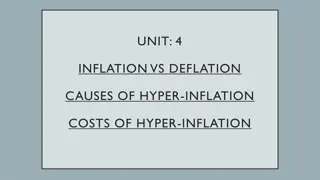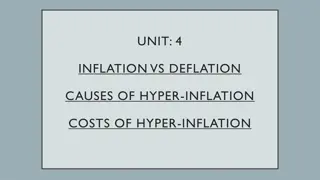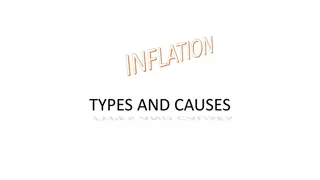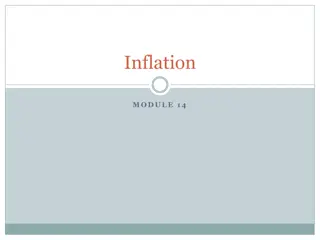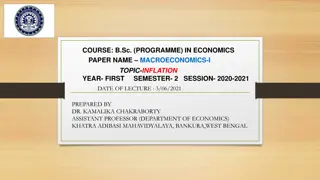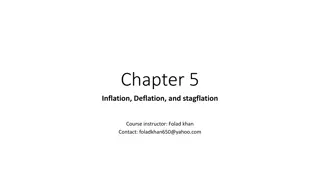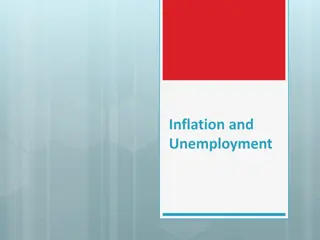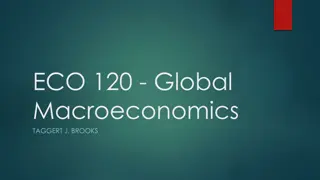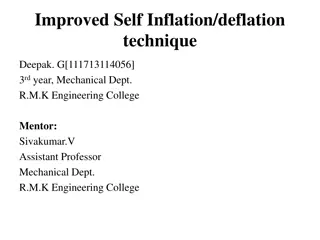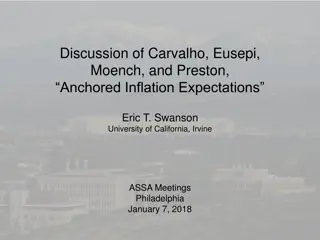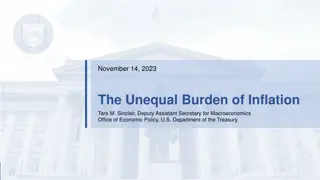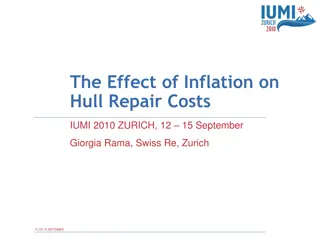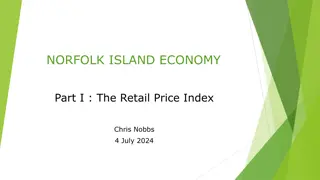Understanding Different Types of Inflation and Their Impacts
Inflation is a sustained increase in the general price level of goods and services in an economy over time, leading to a decrease in purchasing power. This article discusses the various types of inflation - from creeping and walking to galloping and hyperinflation - along with their causes and effects. It delves into demand-pull and cost-push inflation, explaining how each type impacts the economy. Additionally, income redistribution due to inflation is highlighted. Overall, it provides a comprehensive overview of the complex phenomenon of inflation and its implications.
Download Presentation

Please find below an Image/Link to download the presentation.
The content on the website is provided AS IS for your information and personal use only. It may not be sold, licensed, or shared on other websites without obtaining consent from the author. Download presentation by click this link. If you encounter any issues during the download, it is possible that the publisher has removed the file from their server.
E N D
Presentation Transcript
Presented by Prof. Ishfaq Ahmad Bhat Department of Economics Govt. P.G College Rajouri
Introduction Types of Inflation Causes of inflation Effects of Inflation Inflation control Measures 1. 2. 3. 4. 5.
Inflation is a sustained increase in the general price level of goods and services in an economy over a period of time. When the general price level rises, each unit of currency buys fewer goods and services; consequently, inflation reflects a reduction in the purchasing power per unit of money a loss of real value in the medium of exchange and unit of account within the economy.
1. Creeping Inflation Creeping or mild inflation is when prices rise 3 percent a year or less. According to the Federal Reserve, when prices increase 2 percent or less it benefits economic growth. This kind of mild inflation makes consumers expect that prices will keep going up. That boosts demand. 2.Walking Inflation This type of strong, or pernicious, inflation is between 3- 10 percent a year It is harmful to the economy because it heats up economic growth too fast. People start to buy more than they need, just to avoid tomorrow's much higher prices . 3. Galloping Inflation When inflation rises to 10 percent or more, it wreaks havoc on the economy. Money loses value so fast that business and employee income can't keep up with costs and prices. absolute 4. Hyperinflation Hyperinflation is when prices skyrocket more than 50 percent a month. It is very rare. In fact, most examples of hyperinflation have occurred only when governments printed money to pay include Germany in the 1920s, Zimbabwe in the 2000s, and Venezuela in the 2010s for wars. Examples of hyperinflation
Demand-Pull Inflation demand. Many individuals purchasing the same good will cause the price to increase, and when such an event happens to a whole economy for all types of goods, it is called demand-pull inflation. Demand-pull inflation is used by Keynesian economics to describe what happens when price levels rise because of an imbalance in the aggregate supply and demand. When the aggregate demand in an economy strongly outweighs the aggregate supply, prices go up. Economists describe demand-pull inflation as a result of too many dollars chasing too few goods. Demand-pull inflation results from strong consumer Cost-Push Inflation overall price levels go up (inflation) due to increases in the cost of wages and raw materials.Cost-push inflation develops because the higher costs of production factors decreases in aggregate supply (the amount of total production) in the economy. Since there are fewer goods being produced (supply weakens) and demand for these goods remains consistent, the prices of finished goods increase (inflation). Cost-push inflation is a situation in which the
Income redistribution: One risk of higher inflation is that it has a regressive effect on lower-income families and older people in society. This happen when prices for food and domestic utilities such as water and heating rises at a rapid rate Risks of wage inflation: High inflation can lead to an increase in pay claims as people look to protect their real incomes. This can lead to a rise in unit labour costs and lower profits for businesses Business uncertainty: High and volatile inflation is not good for business confidence partly because they cannot be sure of what their costs and prices are likely to be. This uncertainty might lead to a lower level of capital investment spending Falling real incomes: With millions of people facing a cut in their wages or at best a pay freeze, rising inflation leads to a fall in real incomes. Income redistribution: One risk of higher inflation is that it has a regressive effect on lower-income families and older people in society.
Monetary policy One of the important monetary measures is monetary policy. The central bank of the country adopts a number of methods to control the quantity and quality of credit. For this purpose, it raises the bank rates, sells securities in the open market, raises the reserve ratio, and adopts a number of selective credit control measures, such as raising margin requirements and regulating consumer credit. one of the monetary measures is to demonetise currency of higher denominations. Such a measures is usually adopted when there is abundance of black money in the country. Fiscal Measures Monetary policy alone is incapable of controlling inflation. It should, therefore, be supplemented by fiscal measures. Fiscal measures are highly effective for controlling government expenditure, personal consumption expenditure, and private and public investment. a) Reduction in Unnecessary Expenditure (b) Increase in Taxes (c) Increase in Savings




